At Surv, we are on a mission to help build resilience for loved ones in the tribulations ahead. The Surv logo is derived from the cardioid heart, a shape that shows up both in nature and mathematics. Today, we will explain how this cardioid shape is made, and why we see it as a reflection of Jesus Christ.
When founding Surv, and creating the logo, one thing was certain; love needed to be at the forefront. A heart was the obvious symbol, but only after thorough research was it revealed that a natural heart shape shows up in our world - the cardioid. After learning about the ways the cardioid is conceived, it became more and more apparent that this divine shape could be viewed as a reflection of Jesus Christ in a multitude of ways.
The Heart of the Matter
The heart (representing love) is debatably the most important symbol in Christianity, second only to the cross. Even the cross though is a symbol of God's ineffable love for humanity, by giving His only Son as a sacrifice for our sins.
Love, symbolized by the heart, is a vital part of the summation of all God's commandments. Matthew 22:37-40 states "Jesus replied: ‘Love the Lord your God with all your heart and with all your soul and with all your mind.’ This is the first and greatest commandment. And the second is like it: ‘Love your neighbor as yourself.’ All the Law and the Prophets hang on these two commandments.'".
Romans 10:10: “For it is with your heart that you believe and are justified, and it is with your mouth that you profess your faith and are saved", making it the place where a relationship with Christ is rooted.
Matthew 15:18-19 says, “But what comes out of the mouth proceeds from the heart, and this defiles a person. For out of the heart come evil thoughts.” It’s the battleground of sin and virtue.
Ezekiel 36:26: “I will give you a new heart and put a new spirit in you.” This reflects the heart’s role in conversion and sanctification, and God's promise for renewal.
A cardioid isn’t just a random curve; it’s a heart with a story. In the natural world, we see it embodied in the following ways:
1. Caustics in Light Reflection
- When light reflects off a curved surface, it forms a bright curve called a caustic. Shine light into a cylindrical object—like a coffee mug or glass—and the reflection on a flat surface (e.g., liquid inside or a table) traces a cardioid. This is seen in sunlight reflecting off curved water surfaces, dew drops on rounded leaves, or shallow streams with curved banks.
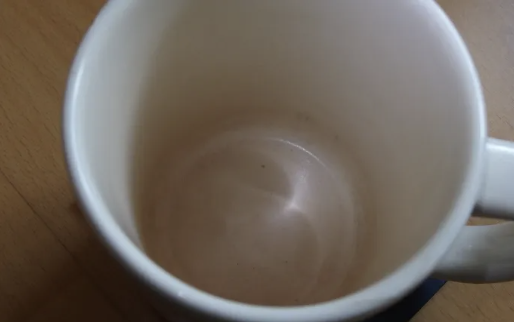
2. The Mandelbrot Set
- In the Mandelbrot set, a fractal from iterating
fc(z)=z2+cf_c(z) = z^2 + cf_c(z) = z^2 + c in the complex plane, the main region is a perfect cardioid—a heart-shaped boundary at the fractal’s core. Fractals echo natural patterns like coastlines, tree branches, or fern leaves, suggesting the cardioid reflects a deep, self-similar order in nature.
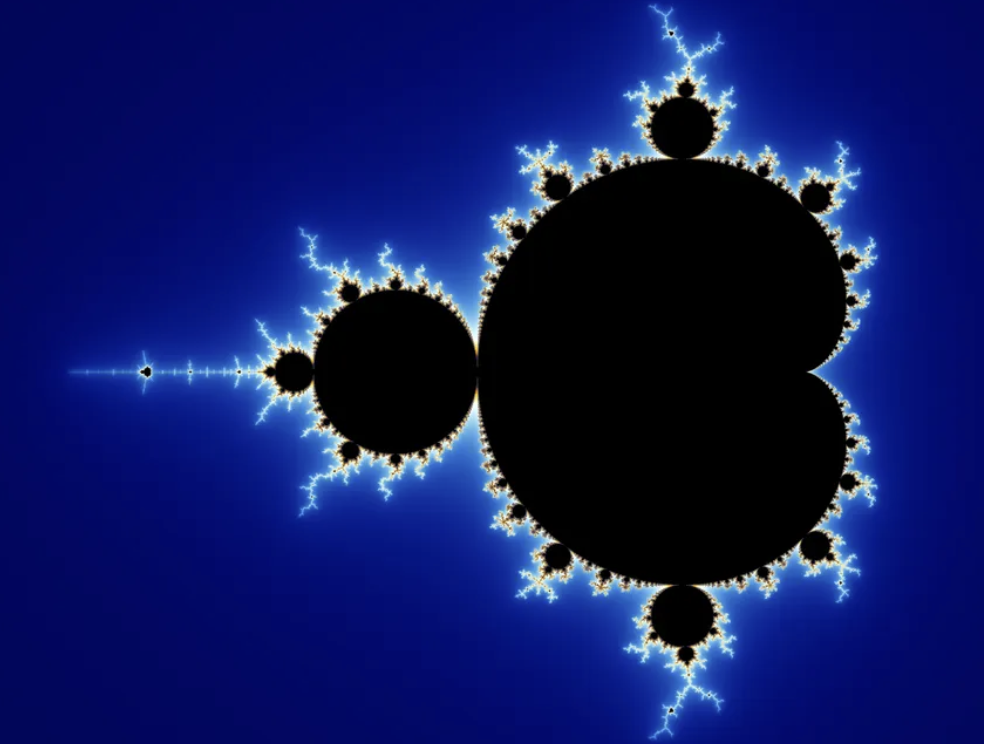
3. Wave Interference Patterns
- When waves (sound, light, or water) from two sources interfere, they can form cardioid-like shapes, especially if one source is offset and frequencies align. Observable in ocean waves around rocks, sound echoing in caves, or light diffracting through slits—though exact cardioids depend on ideal conditions.
4. Biological Shapes
- Apples: A vertical cross-section of an apple often reveals a heart-like shape—wider at the top with a tapered, pointed base resembling a cardioid’s cusp. Varieties like Granny Smith or Honeycrisp show this especially when sliced through the core.
- Other Fruits: Pears, persimmons, or even some figs can mimic cardioids in cross-section.
- Leaves: Heart-shaped leaves from plants like the Eastern Redbud (Cercis canadensis) or certain ivy species (Hedera) have a cusp-like base and broad lobes, echoing the cardioid.
- Heart Anatomy: The human or animal heart, while not a perfect cardioid, has a simplified silhouette—pointed apex and broader chambers—that recalls the shape.
- Seeds and Nuts: Some seeds (e.g., avocado pits) or nutshells (e.g., hazelnuts) show a cardioid-like outline when viewed from certain angles.
5. Cardioid Microphone Sensitivity
- Unidirectional microphones have a cardioid sensitivity pattern, picking up sound from the front in a heart-shaped polar plot. Animals like owls or bats use ear shapes to focus sound directionally, approximating cardioid-like patterns in idealized models—nature’s own “microphones.”
7. Fluid Dynamics and Vortex Patterns
- In fluids, vortexes or eddies around circular objects (e.g., a cylinder in water) can trace cardioid-like paths. Seen in river currents around rocks, air flow over rounded obstacles, or blood flow near heart valves in simplified studies.
8. Crystal Growth and Mineral Patterns
- Certain crystals or mineral deposits grow into cardioid-like shapes when constrained by circular boundaries or radial symmetry. Rare but possible in geodes, snowflakes, or calcite formations.
Next, let's look at the instances where a cardioid shows up in mathematics:
1. Two circles of the same size
One method for creating a cardioid mathematically is simply by rolling a circle around another circle of equal size, with a single point on its edge tracing a path. What emerges is a shape with a sharp cusp and a smooth, continuous loop—a perfect heart. Mathematically, it’s defined as r = a(1 + \cos\theta), a formula that unfolds into this timeless symbol.
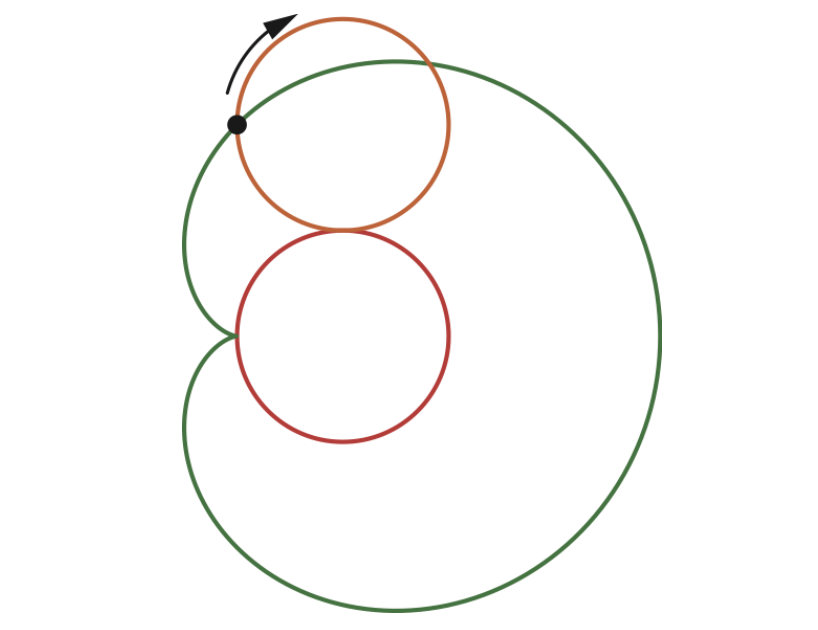
Another way a cardioid can be formed is through an "envelope" of a family of curves—either circles or lines—where the envelope is the curve that tangentially touches each member of the family. Here are two key methods:
2. Envelope of Circles
- Start with a fixed circle and pick a point ( P ) on its circumference.
- Draw a series of circles whose centers lie on the original circle and pass through ( P ).
- The envelope of these circles traces a cardioid. (Imagine the boundary that hugs all these circles—it’s heart-shaped with a cusp at ( P ).)
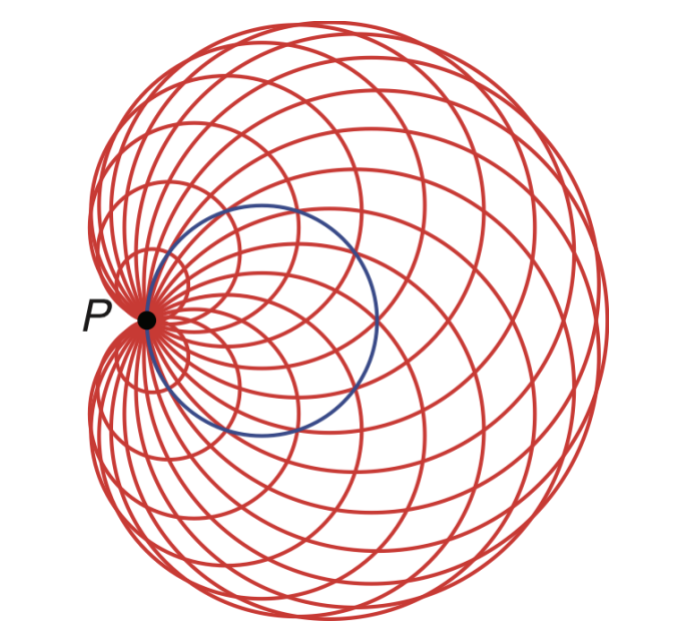
3. Envelope of Lines (Chord Method)
- Take a circle (e.g., center at ( (1,0) ), radius 3) and mark ( N ) evenly spaced points around it, numbered 0 to N−1N-1N-1, starting at P=(4,0)P = (4,0)P = (4,0).
- For each point ( n ), draw a line to point ( 2n ) (mod ( N )), e.g., for
N=54N = 54N = 54, connect 5 to 10, 19 to 38, 31 to 8 (since
62 minus 54=8). - These lines form an envelope that’s a cardioid, specifically with polar equation
r=2(1+cosθ)r = 2(1 + \cos\theta)r = 2(1 + \cos\theta).
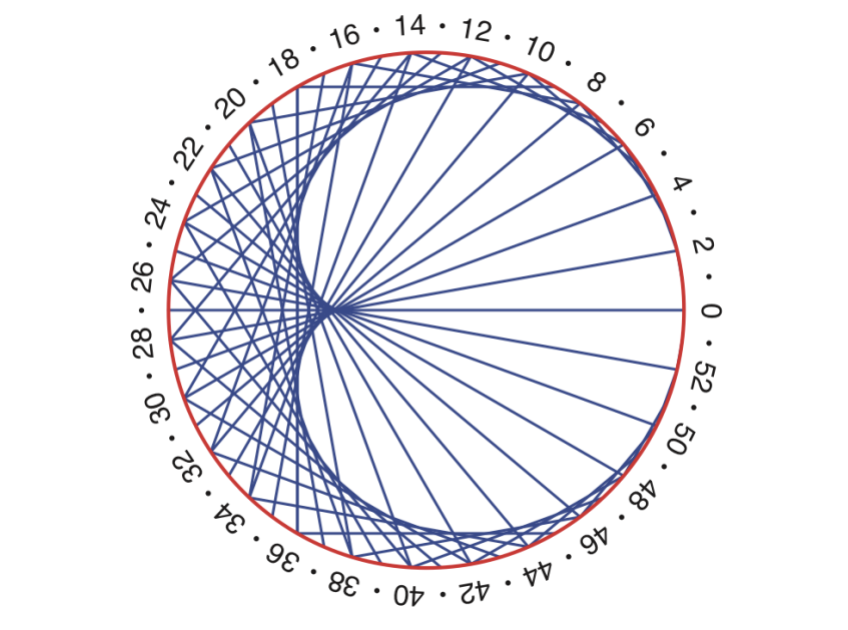
Why does Surv view the cardioid as a reflection of Jesus Christ?
The first analogy that became apparent was how the cardioid can be created by two circles, that are the same size, with one encircling the other. Encircling is defined as forming a circle around, or surrounding another object. Jesus Christ is God in human form. He came down to earth as a human, 'the same size' as us, and surrounds us with His love, if we are willing to let Him into our hearts. How beautiful is it, that having one circle surround another of the same size, creates a cardioid heart shape?
Next look at the envelope of circles, where a cardioid occurs from a series of circles, increasing in size, that all have their centers lying on the original circle. The increasing size could be seen as the God aspect of Jesus Christ. 100% God and 100% man, known as the Hypostatic Union. As God, He can be outside of time, or be affected by time, by His choosing. He can also go down to an infinitely small size, or be infinitely large. Both concepts are hard to comprehend as humans, but this analogy reflects Jesus' Godly nature. Yet no matter how small or how large the circle is, its center is always lying on the original circle. Jesus is always with us, no matter what.
The third mathematical embodiment of the cardioid, the envelope of lines, is where you take a circle with equally spaced points around the edge, and double the points' value with a line connecting them. For example, connect points 2 and 4, 5 and 10, 10 and 20, etc. This aspect is analogous to Jesus again coming in human form, making Himself the same size as us, so we could connect with Him. What manifests out of this equation is an incredible cardioid shape with an appearance of rays of light shining within the heart, and almost chaos or a 'storm' on the outside. The circle is viewed as the world outside of us, which often brings literal and metaphorical storms into our lives. But Jesus can help us get through any storm by shining His light within us and keeping our focus on Him instead of the storm. Not only that, He can literally calm any storm, as is shown in Mark 4:35-41. He is our light, our protector, our healer, and we can weather any storm with Him as our foundation.
That sharp point on the cardioid? It’s called a cusp, and it’s where everything changes. In the rolling circle method, it’s the instant the tracing point aligns with the fixed circle’s edge—a singular, defining moment. In the envelope lines method, it's the ray of light that shines into our hearts. For Christians, this evokes the birth as well as the crucifixion of Jesus Christ. He came to earth to give us the ultimate act of love and sacrifice.
The cardioid doesn’t end at the cusp—it loops back, whole and unbroken. This echoes Jesus as the “Alpha and Omega” (Revelation 22:13), the beginning and the end, whose love encircles us eternally. It’s a shape that holds together, much like Christ holds all things together (Colossians 1:17).
Cardioids don’t just live on graph paper—they show up in the world around us. Shine a light into a coffee cup, and the reflection forms a cardioid caustic. Jesus Christ shines His light into our cup, and if we let Him, will fill it with a spring of water welling up to eternal life, so we never thirst again (John 4:10-14).
Look at the Mandelbrot set, a relatively simple definition that exhibits great complexity. When magnified, it brings incredible awe as the fractals reveal more and more elaboration, into infinity. At the center of this is the cardioid heart, representing Jesus in his omnipresent and omniscient form, infinite and ineffable.
Even man-made and natural microphones use cardioids to focus sound. This could be viewed as analogous to Jesus helping us focus on what matters, through His word and teachings, even when the world around us is constantly trying to distract us with the wrong noises.
Next time you see a heart shape—in a cup, on a graph, or in your own story—think of the cardioid. Think of Jesus Christ. And if you haven't already, consider letting Him into your heart.
_Surv_
Reference: https://divisbyzero.com/2018/04/02/i-heart-cardioids/